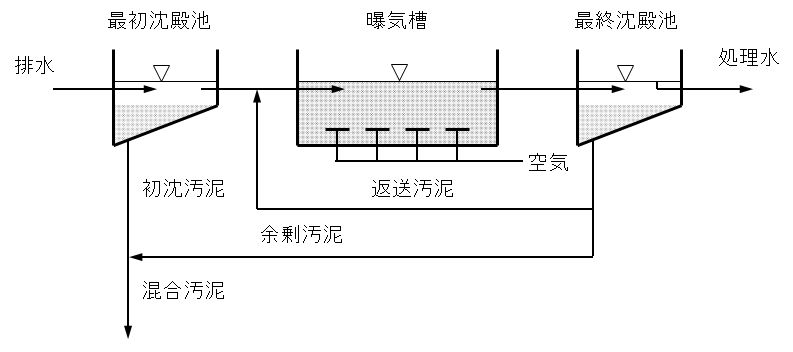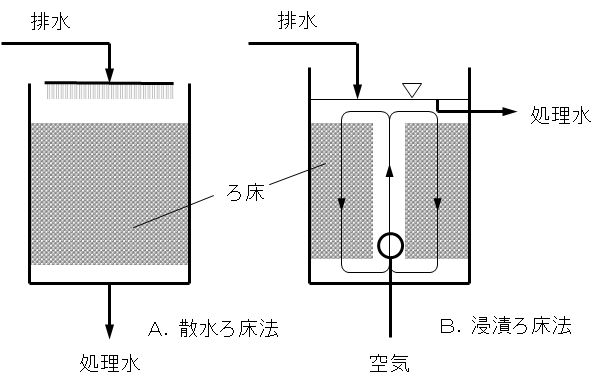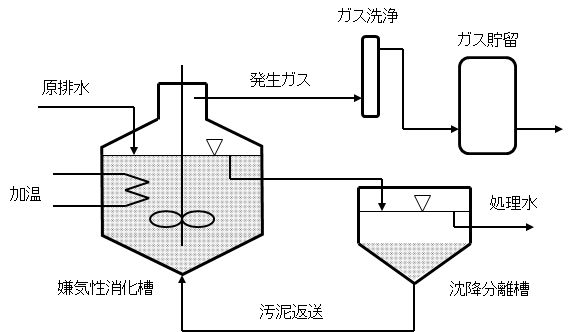Outline of water purification technology – Biotechnology
村上定瞭(水浄化フォーラム), Sadaaki Murakami (Water & Solutions Forum)
生物技術
生物を用いた水の浄化には、微生物の種類及びその培養法により表1に示すように分類される。
有機物の分解やその増殖に酸素を必要とする微生物を用いる好気性生物処理と、酸素を必要としない微生物を用いる嫌気性生物処理に分けられる。
また、適用する微生物を生物反応槽内の水中に懸濁状態で維持する浮遊型処理法と微生物を媒体に付着させて維持する付着型処理法に分けられる。付着型は生物膜法とも呼ばれる。
好気性生物処理には浮遊型として代表的なものに活性汚泥法、付着型として散水ろ床法、回転円板法、接触曝気法などがある。
生物処理では、汚濁物質を微生物に摂取させて無害な物質に代謝分解するが、その際に微生物が増殖するため、この増殖した微生物(生物汚泥)の取り出し・処分が必要になる。
水浄化に係る生物技術の詳細は、別ページに記載されているので参照されたい(実験技術および技術解説)。
Biotechnology
Purification of water using organisms is classified as shown in Table 1 depending on the type of microorganism and its culture method.
It is divided into aerobic biological treatment using microorganisms that require oxygen for the decomposition of organic matters and the growth, and anaerobic biological treatment using microorganisms that do not require oxygen.
Further, it is divided into a suspended type treatment method in which the applied microorganisms are maintained in a suspended state in water in the biological reaction tank, and an attachment type treatment method in which the microorganisms are adhered to and maintained in a medium. The attachment type is also called a biofilm method.
Activated sludge method is representative of suspended type for aerobic biological treatment, and adherent types are sprinkling filter method, rotary disk method, contact aeration method, etc..
In biological treatment, pollutants are ingested by microorganisms and metabolically decomposed into harmless substances. At that time, since the microorganisms proliferate, it is necessary to take out and dispose the proliferated microorganisms (biological sludge).
For details of biotechnology related to water purification, refer to the other pages (
Experimental techniques and Technical explanations)
.
Table 1 Biological wastewater treatment methods.

1.活性汚泥法
下水や産業排水の処理に広く用いられている活性汚泥法の装置を図1に示す。土砂や紙などの異物を除いた排水は最初沈殿池に送られ、固形物質、油分などが除去されて、生物反応槽(曝気槽)に導かれ曝気攪拌下で微生物フロック(活性汚泥)と接触する(滞留時間4~24時間)。
ここで排水中の有機物は活性汚泥により吸着・摂取・分解される。活性汚泥混合液は、次の最終沈殿池で重力沈降(沈降時間2~3時間)により活性汚泥と処理水とに分離され、処理水は塩素殺菌されて放流される。この活性汚泥処理では排水中のBODは95%以上が除去される。
一方、活性汚泥の一部は返送汚泥として曝気槽に戻され、残りは余剰汚泥として、最初沈殿池で除去された固形物質(初沈汚泥)ともに系外に排出されて別途に処理・処分される。活性汚泥法を用いた下水処理場では、処理水量の1~2%の混合汚泥が発生している。通常、この混合汚泥は濃縮、消化(嫌気性処理により、有機物の一部をメタンや二酸化炭素へ変換して除去する)、洗浄、脱水、乾燥の後、焼却され、最後に残った灰分は埋立処分される。最近では、混合汚泥の一部は肥料、大部分の焼却灰分は建設資材の原料として有効利用されている。
1. Activated sludge method
Fig.1 shows an apparatus of the activated sludge method which is widely used for treating sewage and industrial wastewater. Wastewater from which foreign substances such as sand and paper are removed is sent to the first settling basin, where solid substances and oils are removed, and then introduced into a biological reaction tank (aeration tank) and contacted with microbial flocs (activated sludge) under aeration and stirring (residence time 4 to 24 hours).
Here, organic matter in wastewater is adsorbed, ingested and decomposed by activated sludge. The activated sludge mixture is separated into activated sludge and treated water by gravity settling (settling time 2 to 3 hours) in the next final settling tank, and treated water is chlorinated and discharged. This activated sludge treatment removes 95% or more of BOD from wastewater.
On the other hand, a part of the activated sludge is returned to the aeration tank as return sludge, and the rest, which is called as excess sludge, is taken out together with the first settling sludge in the first settling tank. Both are discharged to the outside of the system for separate treatment and disposal. At a sewage treatment plant using the activated sludge method, mixed sludge is generated in an amount of 1 to 2% of the amount of treated water. Normally, after this mixed sludge is concentrated, digested (anaerobic treatment converts some organic matter into methane and carbon dioxide for removal), washing, dehydration, and drying, it is incinerated and the last remaining ash is landfilled. Recently, some of the mixed sludge is used as fertilizer, and most of the incinerated ash is effectively used as a raw material for construction materials.

図1 活性汚泥法による排水処理例
Fig.1 Example of wastewater treatment by activated sludge method.
(Design and operating factors of the activated sludge method and experimental method are described separately.)
2.生物膜法
活性汚泥法では処理にかかわる微生物を水とともに流動させるのに対し、微生物を支持体(あるいは接触材)である個体表面に膜状あるいは塊状に固定して処理を行う方法があり、これを生物膜法という。微生物の支持体は、材質、形状、構造も様々なものが用いられ、この支持体を装置内に充填した部分をろ床という。代表的な生物膜法として散水ろ床法、浸漬ろ床法(または接触曝気法)、回転円板法がある。散水ろ床法及び浸漬ろ床の装置を図2に示す。
生物膜法の特徴は生物相の多様性にあり、原生動物から昆虫のような小動物、さらに細菌も好気性、嫌気性と処理装置ごとに一つの生態系が成立している。活性汚泥法では微生物が余剰汚泥として抜き取られので、装置内である滞留時間を持つのに対して、生物膜は装置内に長時間留まって保持される部分があり、アンモニアの酸化(硝化)が容易に進行する。また、食物連鎖も加わり、活性汚泥法より余剰汚泥量が少ない。阻害物質に対する抵抗力も強く、運転が簡単であることが特徴である。
2. Biofilm method
In the activated sludge method, the microorganisms involved in the treatment flow with water, but there is a method in which the microorganisms are fixed in the form of a film or agglomerate on the surface of the solid body that is the support (or contact material). A variety of materials, shapes, and structures are used as the support for microorganisms, and the portion where the support is filled in the device is called a filter bed. Typical biofilm methods include sprinkling filter method, immersion filter method (or contact aeration method), and rotating disk method. Fig.2 shows an apparatus for the sprinkling filter method and the immersion filter bed.
A feature of the biofilm method is the diversity of biota, and a single ecosystem is established for each processing device, including aerobic and anaerobic bacteria from protozoa to small animals such as insects. In the activated sludge method, microorganisms are extracted as excess sludge, so while it has a certain retention time in the device, biofilm has a part that is retained and retained in the device for a long time, and ammonia oxidation (nitrification) occurs. It progresses easily. Also, due to the addition of the food chain, the amount of excess sludge is smaller than that of the activated sludge method. It is characterized by strong resistance to inhibitors and easy operation.

図2 生物膜法による排水処理の例
Fig.2 Example of wastewater treatment by biofilm method.
3.嫌気性生物処理
嫌気性生物処理は嫌気性消化法とも呼ばれ、固形状や溶解性の有機物を嫌気性細菌の作用によりメタンや二酸化炭素に還元分解するもので、メタン発酵法によって代表される。図3に嫌気性消化法の一例を示す。嫌気性消化槽内の反応は図4に示すように三段階で行われる。第一段では炭水化物、タンパク質、脂質などが加水分解酵素により単糖類、アミノ酸、脂肪酸などの低分子物質に変換される過程である。第二段階でこれらの低分子物質が有機酸へ変換され、第三段階(メタン発酵)では有機酸がメタンと二酸化炭素へ変換される。
嫌気性生物処理の最も大きな特徴は、曝気を必要とする好気性生物処理に比べて所要電力が少ないことと同時に、回収したメタンガスが燃料や電気などのエネルギー源として利用できることである。
近年、原水滞留時間と汚泥(微生物)滞留時間を独立して制御することにより、反応槽内に高濃度の微生物を固定・保持して処理効率を高める方式が嫌気性処理の分野でも試みられている。生物の固定化技術、汚泥の自己造粒化技術などが開発され、溶解性の易生分解性有機性排水の処理を中心に、従来の嫌気法に比べて数倍から数十倍の処理能力を持つ嫌気処理法が開発されている。適用範囲も従来の中・高濃度排水中心から、低濃度排水や化学系排水へも徐々に拡大されつつある。BOD濃度が1,000mg/L以上の場合、嫌気性生物処理が経済的に有利になるといわれているが、今後、BOD低濃度の排水処理への応用が期待される。
3. Anaerobic treatment
Anaerobic biological treatment is also called anaerobic digestion method, which reduces and decomposes solid or soluble organic matter into methane and carbon dioxide by the action of anaerobic bacteria, and is represented by a methane fermentation method. Figure 3 shows an example of the anaerobic digestion method. The reaction in the anaerobic digester is performed in three steps as shown in Figure 4. The first step is the process in which carbohydrates, proteins, lipids, etc. are converted into low molecular weight substances such as monosaccharides, amino acids, and fatty acids by hydrolases. In the second stage these low molecular weight substances are converted to organic acids, and in the third stage (methane fermentation) the organic acids are converted to methane and carbon dioxide.
The most important feature of anaerobic biotreatment is that it requires less electric power than aerobic biotreatment that requires aeration, and at the same time, the recovered methane gas can be used as an energy source such as fuel and electricity.
In recent years, a method has been attempted in the field of anaerobic treatment in which the retention time of raw water and the retention time of sludge (microorganisms) are independently controlled to fix and retain high-concentration microorganisms in the reaction tank to enhance treatment efficiency. Bio-immobilization technology, sludge self-granulation technology, etc. have been developed, and the processing capacity is several to several tens of times that of the conventional anaerobic method, focusing on the treatment of soluble easily biodegradable organic wastewater. The range of application is gradually expanding from middle/high-concentration wastewater to low-concentration wastewater and chemical wastewater. When the BOD concentration is 1,000 mg/L or more, it is said that the treatment of anaerobic organisms will be economically advantageous, but it is expected to be applied to the treatment of wastewater having a low BOD concentration in the future.

図3 嫌気性消化法による有機性排水の処理例
Fig.3 Example of treatment of organic wastewater by anaerobic digestion method.

図4 嫌気性消化による有機物の分解過程
(参考:用水廃水便覧編集委員会、用水廃水便覧、丸善、p.423、1973)
Fig.4 Organochemical decomposition process by anaerobic digestion.
4.生物学的窒素・リン除去
窒素は硝化-脱窒法と呼ばれる生物法により除去される。まず、アンモニアは好気性微生物(硝化菌)によって硝酸イオンに酸化される。次に、硝酸イオンは通性嫌気性菌(脱膣菌)により有機炭素をエネルギー源として窒素分子に還元される。
活性汚泥を嫌気および好気の条件に交互にさらすことにより、リンを除去することができる。嫌気状態では細胞中のリンは溶解性リンとして溶出され、逆に好気状態ではリンは細胞内に取り込まれる。リンを過剰に含む汚泥を引き抜くか、または溶出したリンを不溶性塩として分離することにより、排水中からリンを除去することができる。
4. Biological nitrogen and phosphorus removal
Nitrogen is removed by a biological method called nitrification-denitrification. First, ammonia is oxidized to nitrate ions by aerobic microorganisms (nitrifying bacteria). Next, nitrate ions are reduced to nitrogen molecules by using facultative anaerobic bacteria (devaginating bacteria) with organic carbon as an energy source.
Phosphorus can be removed by alternating exposure of activated sludge to anaerobic and aerobic conditions. In the anaerobic state, phosphorus in the cell is eluted as soluble phosphorus, and conversely, in the aerobic state, phosphorus is taken into the cell. Phosphorus can be removed from the wastewater by pulling out sludge containing excess phosphorus or separating eluted phosphorus as an insoluble salt.
